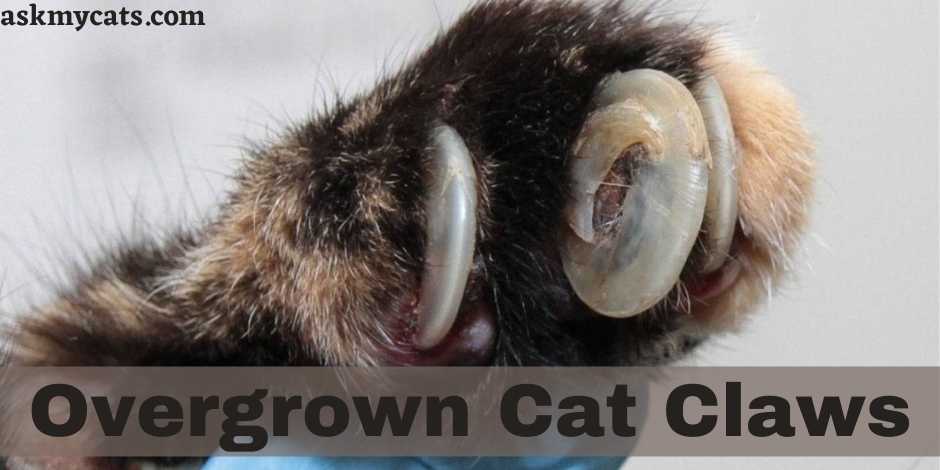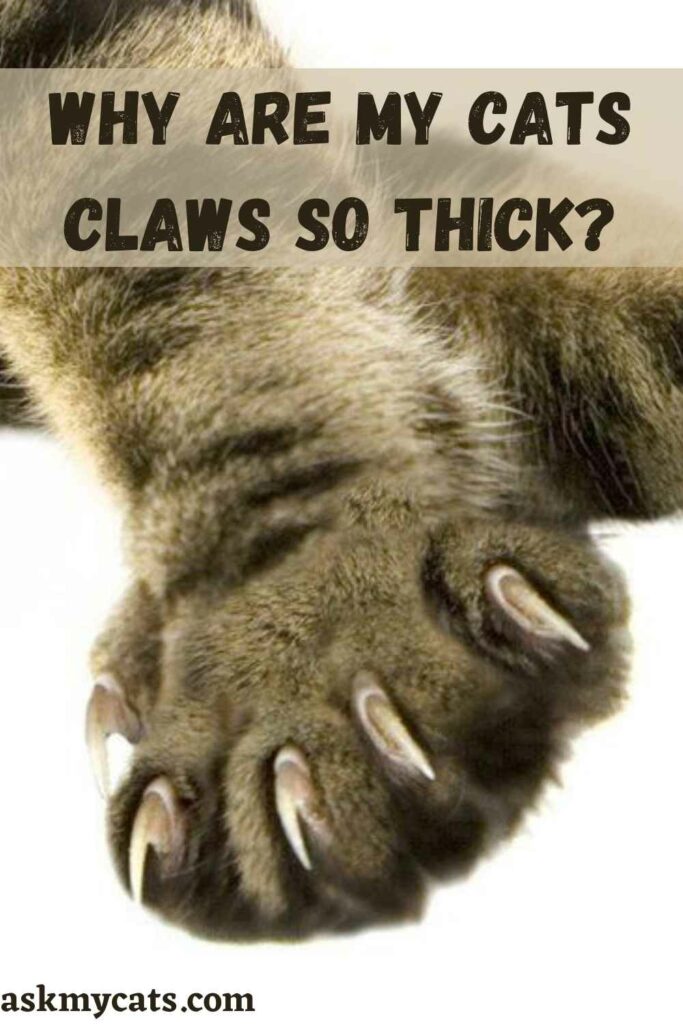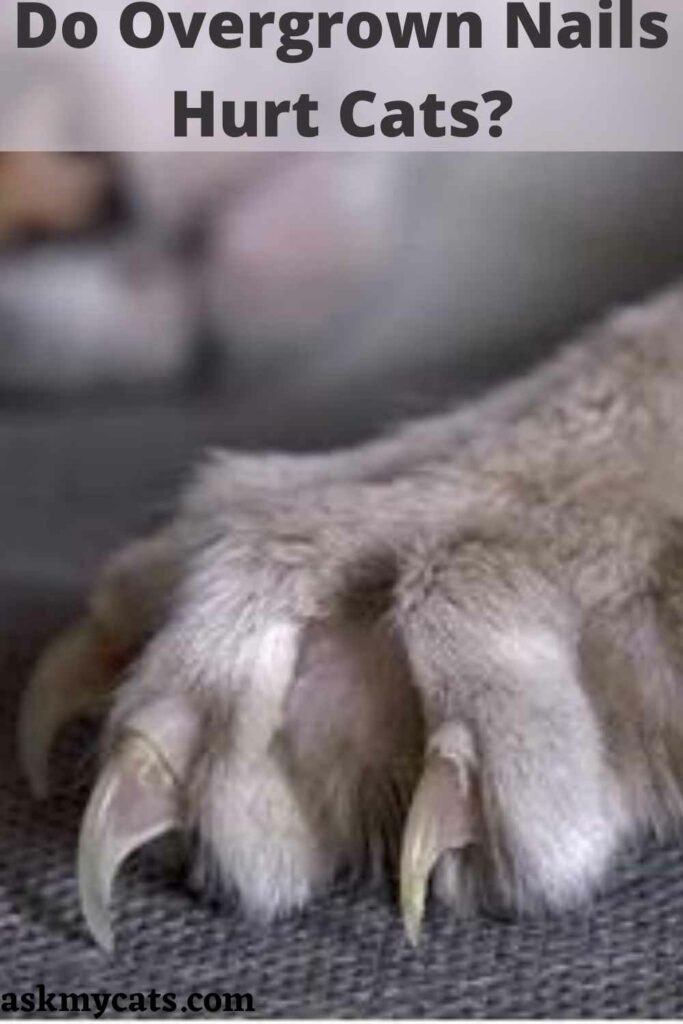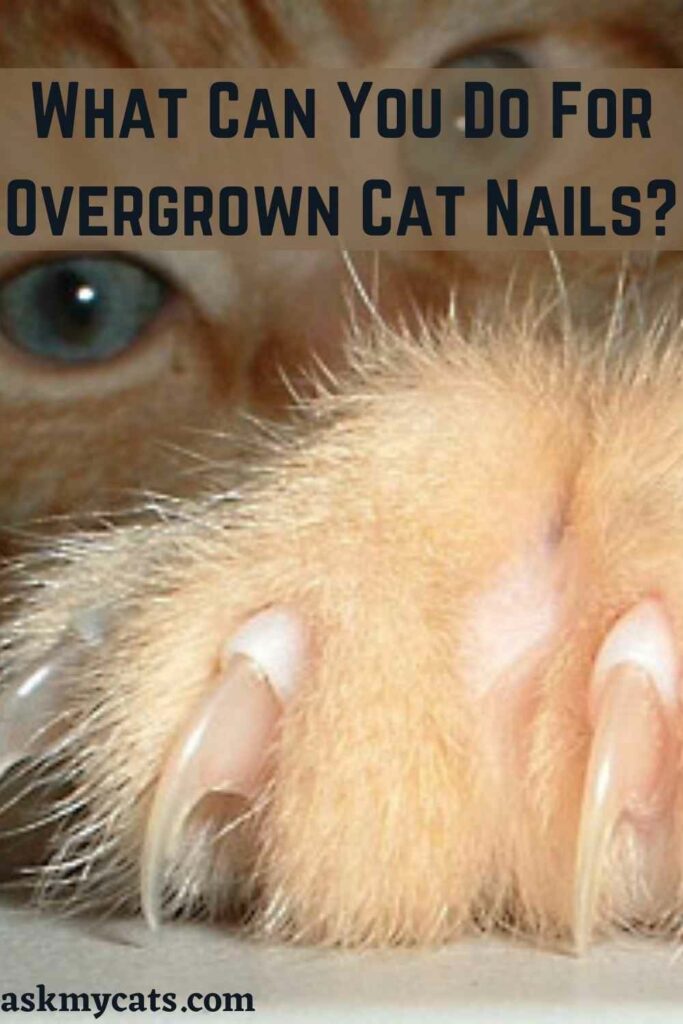Overgrown cat claws are frequent in senior cats, and in the worst-case scenario, the overgrown claw coils into the paw pad, causing paw pad trauma.
Reduced exercise and grooming in older cats increase the problem of onychauxis, a thickening of the claw linked with aging.
An ingrown claw can be painful for your cat, and if left untreated, it can lead to ulcers, infections, lameness, and other serious problems. Fortunately, ingrown nails are simple to treat and keep your pets on stable footing.
This article will talk about your cat’s overgrown claws and how you can help them.


Give Your Cat the Perfect Day
Get the Free Ebook!
Why Are My Cats Claws So Thick?
Your cat’s claw is thick because the claws are no longer shedding their outer sheaths.

A cat’s nails naturally wear down as they are used, but indoor cats rarely get enough exercise or other activities to wear them down as much as they should.
If the nails aren’t clipped on a regular basis, they can curl over and dig into a pet’s sensitive skin, causing sores and infections.
Dewclaws, the nails that are higher on a pet’s legs and never contact the ground to fade off naturally, are especially prone to ingrown nails.
If a cat’s toes are deformed, or the nail is misaligned, it can result in twisted and turned nails that can develop ingrown.
Long-haired cat breeds, cats with extra toes, are more prone to nail problems.
Ingrown nails are more common in older cats because their nails are more brittle and develop at different rates, which, when combined with a less active senior lifestyle, can raise the risk of ingrown nails.
The claws that you spotted aren’t losing their outer sheaths anymore. The claws of a cat are replaced from the inside out as they grow.
The dull outer coating is removed, and the razor-sharp claw beneath it takes its place. This is a never-ending process that is aided by your cat’s clawing activity.
They aren’t clawing at things to get back at you, that’s for sure. Cats use their claws to clean themselves and shed their sheaths.
It is not uncommon for senior cats to acquire thick claws. Cats’ claws grow faster and are more difficult to shed as they become older.
When claws aren’t trimmed frequently enough, or the cat doesn’t use an adequate scratching surface frequently enough, problems arise.
So there are two things you can do right now to help. Your cat’s nails should be trimmed on a regular basis, even the thicker ones, and he should have lots of scratching surfaces he enjoys.
You might also like to read about do cats claws grow back
Do Overgrown Nails Hurt Cats?
Yes, overgrown nails hurt cats.

The layers of your cat’s nails might build up over time. To keep the nail from becoming ingrown and painful, these layers must be removed on a regular basis.
Younger cats tend to keep their nails in check by scratching the layers off using scratching posts, but this isn’t always successful; therefore, clipping may be required to alleviate these issues.
Overgrown nails become curled and do not fully retract.
If your cat’s nails become stuck in carpets or other soft surfaces, or if she can no longer retract her nails, you’ll know they’ve gotten too long.
Overgrown cat nails, which grow in a curve towards your cat’s paw pad, can be caused by not trimming nails and allowing the layers to build up.
If the nail becomes too long, it may puncture the paw pad, resulting in painful sores, bleeding, and infection. If your cat is limping, licking its paw, or bleeding, inspect its paws for a wound caused by the nail.
Because these injuries can be quite painful, you may need to have the nail cut and removed by a veterinarian.
Nails that are severely overgrown and curled might grow into the footpad, causing severe pain and mobility issues. As a result, it’s critical to maintain your cat’s nails short. To avoid reaching this position, cats should get their nails cut every 10 days to 2 weeks.
Elderly cats often have a harder time retracting their claws than younger cats. As a result, they’re more likely to get their nails hooked in carpets or furniture, resulting in damaged nails.
Broken nails are extremely painful for cats, but they may simply be avoided by keeping the nails short and blunt.
You might also like to read about cat can't retract claws
What Can You Do For Overgrown Cat Nails?
If you want to treat the overgrown nail of your cat, the best step is to take it to the vet.

Depending on how far the ingrown nail has gone and the severity of any wounds on the pad, ingrown nails are usually simple to treat.
Because of the potential of infection and the sensitivity of a painful foot, it is always recommended to have the pet treated by a veterinarian.
They’ll look at the ingrown nail and clip it if necessary, as well as clean out the wound and treat any infection.
A course of oral or topical antibiotics may be administered in severe cases or as a preventative measure against more serious infections.
If a dewclaw or a malformed toe causes the condition, the veterinarian may prescribe declawing the pet only on that toe to avoid recurrence.
You might also like to check these points before declawed cats for adoption
If the ingrown nail has only recently begun to bother you, you may be able to treat it yourself.
To begin, securely bind the animal so that you can examine the claw thoroughly. Trim the uneven nail just above where it enters the animal’s paw with scissor-type pet nail clippers or human nail clippers.
The nail tip may then easily come out of the pad, or it may be necessary to delicately remove it using blunt-tipped tweezers.
To reduce the danger of infection, clean the pad with mild antiseptic soap and repeat the process 1-2 times each day for many days while the pad recovers.
Trim the abnormally long nail in small increments every few days until it is down to a normal, manageable length (the sensitive quick inside the nail will gradually retreat as the nail is reduced).
Also, check out what happens if you don't trim your cat's nails
How Do You Cut Overgrown Cat Claws?
To cut overgrown cat nails, you need to be extra careful as your cat’s nail bed becomes extremely sensitive because of extra sheaths.
Trimming a cat’s claws can be difficult, but it will be made simpler if you associate the process with pleasurable things like food.
After you’ve successfully cut at least one claw, always give your cat a treat. Take it one claw at a time if you have to, but don’t give up.
Hold the cat firmly between your thumb and forefinger and grab the paw between your thumb and forefinger. Extend the claw by pressing lightly.
You don’t want to cut too much when dealing with a battling cat mistakenly. Never cut into the quick, which is the pink area evident in most cat claws.
Only the tips should be trimmed. You just need to trim the claws on your cat’s front paws because most cats will take care of their back claws on their own.
You might also like to read about why do cats hate getting their nails cut
You might try to assist your cat in shed those extra sheaths by removing thicker nails, but be careful. Because of the unshed sheaths pressing into his nail bed, it’s likely highly sensitive.
Simply stretching his claw between your fingers could cause a great deal of discomfort. If you can do the task quickly, do so and treat your cat for his patience.
All cats require one vertical scratching surface that is at least twice their shoulder height, as well as one good horizontal scratcher, in addition to regular trimmings.
These can be covered in any material, but they must be rough in order to attract cats. Consider the kind of surfaces that cats would come across in the wild.
The scratching surface should be as close to tree bark as possible, as this will increase the likelihood of the scratcher being utilized.
Popular choices include corrugated cardboard, sisal, and Berber carpet. Soft carpeted posts should be avoided. These are more appealing to people than to cats.
Assume that your cat’s nails have been properly clipped and that he has scratching posts that he utilizes on a frequent basis. So, what’s next?
If your cat no longer appears to be in pain, it’s better just to keep those larger nails cut. If he’s showing you that his claws are still bothering him, it’s time to take him to the vet.
Your veterinarian should be your first port of call if you suspect a claw has become ingrown in any way.
You would like to read about what to do if cat nail bleeding after cutting
How To Prevent Ingrown Nails In Cats?
You can prevent ingrown nails in cats by giving them adequate exercise on a variety of surfaces.
Giving your cat enough movement on a variety of surfaces, such as asphalt, concrete, gravel, and other abrasive surfaces will help maintain their nails naturally filed.
Still, regular trimming will be required to avoid unduly long nails. Trims should be done every 4-8 weeks as part of routine grooming, depending on the breed, lifestyle, age, and condition of the pet’s nails.
If the cat’s toes are misplaced or a malformation that puts them at risk for recurrent ingrown nails, declawing may be an option, or those nails may require more frequent clipping.
Cat owners should check their cats’ nails on a regular basis for signs of nail overgrowth so that ingrown nails can be treated before they become bothersome.
Long hair on a cat’s foot can be trimmed to make problems more visible before they become wounds.
Ingrown nails can be uncomfortable and hazardous for cats, but these unintentional injuries can be avoided with careful care. If your cat develops an ingrown nail, it is simply treated, and it will soon be able to walk on all fours without difficulty.
Also, find out how to remove cat nail caps
Frequently Asked Questions
What is Osteoarthritis?
Osteoarthritis is a rather prevalent health issue for cats in their later years. Claw overgrowth is generally a telltale indicator of the illness, along with joint discomfort, decreased activity, and mobility issues. If your cat’s overgrowth is causing her discomfort, consider the possibility that she has osteoarthritis and make an appointment with a veterinarian as soon as possible.
What Are The Symptoms Of Cat Ingrown Claws?
If your cat appears to be in agony, it’s possible that a cat claw has grown out of the pad on its foot! When this happens, it’s typical to see individuals limp. Claw pain (onychalgia), nail discoloration, pus discharge, bleeding, limping, swelling, and inflammation around the nails, which may encompass the paw and foot, excessive licking of its paws, and abnormal-looking claws are some of the other symptoms.
How To Keep Cat Calm While Cutting Overgrown Nails?
Unfortunately, trimming cat nails can be difficult because most cats dislike having their nails trimmed. Some of the tips are – 1. Choose a comfortable chair in a quiet room where your cat can’t look out the window, 2. hold your cat in your lap when she’s relaxed and a little sleepy, such as after a meal, and 3. massage your cat’s front legs and paws for at least several days before the nail trim, pressing gently on each foot pad with your thumb and forefinger to extend the corresponding nail. Remove the pressure and immediately reward your cat with a cat treat.
Final Words
Allowing your cat’s claw condition to spiral out of control could endanger her health. Her claws will become overgrown, causing her pain and making it difficult for her to walk.
This could cause her claws to tear. Tearing can sometimes lead to infection, which is the last thing a geriatric cat needs.
Claw trimming neglect can put your furniture at risk, in addition to jeopardizing your beloved pet’s health.
If you have any unanswered questions, ask us in the comments section.

Thanks so much for this as Julian is my only cat to have had this problem, and I thought it was uncommon.
Great to know that you found this article helpful.
Happy cat parenting